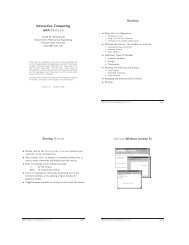"O Soul, Come Back!" A Study in The Changing Conceptions of The ...
"O Soul, Come Back!" A Study in The Changing Conceptions of The ...
"O Soul, Come Back!" A Study in The Changing Conceptions of The ...
You also want an ePaper? Increase the reach of your titles
YUMPU automatically turns print PDFs into web optimized ePapers that Google loves.
386 YING-SHIH YUevidence suggests that pre-Buddhist Ch<strong>in</strong>ese beliefs about a heavenlyworld above and an underworld below were closely related to thedualistic conception <strong>of</strong> soul, the hun and the p'o. At death the hunand the p 'o were thought to go separate ways, the former return<strong>in</strong>gto heaven and the latter to earth. <strong>The</strong> idea <strong>of</strong> heaven and hell as oppos<strong>in</strong>gsites as reward and punishment <strong>in</strong> the afterlife was not fullydeveloped <strong>in</strong> Ch<strong>in</strong>ese thought until the com<strong>in</strong>g <strong>of</strong> Buddhism.THE RISE OF HSIEN IMMORTALITYTHE RESTRUCTURINGANDOF THE AFTERWORLDA historical account <strong>of</strong> the Ch<strong>in</strong>ese conception <strong>of</strong> afterlife,however, would rema<strong>in</strong> <strong>in</strong>complete without a brief discussion <strong>of</strong> thefundamental transformation it underwent dur<strong>in</strong>g the reign <strong>of</strong>Emperor Wu <strong>of</strong> Han (140-87 B.C.). By this transformation we referto the development <strong>of</strong> the cult <strong>of</strong> hsien ji immortality.59Hsien was a unique idea <strong>in</strong> ancient Ch<strong>in</strong>ese thought and probablybegan as a romantic conception <strong>of</strong> total spiritual freedom. A prototype<strong>of</strong> hsien immortal may be found <strong>in</strong> the beg<strong>in</strong>n<strong>in</strong>g chapter <strong>of</strong>the Chuang Tzu +E- where a Div<strong>in</strong>e Man is described as follows:<strong>The</strong>re is a Div<strong>in</strong>e Man liv<strong>in</strong>g on faraway Kuyeh Mounta<strong>in</strong>, with sk<strong>in</strong> like ice orsnow, and gentle and shy like a young girl. He doesn't eat the five gra<strong>in</strong>s, but sucksthe w<strong>in</strong>d and dr<strong>in</strong>ks the dew, climbs up on clouds and mists, rides a fly<strong>in</strong>g dragon,and wanders beyond the four seas.60<strong>The</strong> important th<strong>in</strong>g to note here is that the Div<strong>in</strong>e Man does noteat anyth<strong>in</strong>g earthly such as the five gra<strong>in</strong>s but only "sucks the w<strong>in</strong>dand dr<strong>in</strong>ks the dew," phenomena that come from heaven. Elsewherethe Chuang Tzu also mentions the method <strong>of</strong> regulat<strong>in</strong>g ormanipulat<strong>in</strong>g the ch 'i or breath (tao-y<strong>in</strong> ig 1) as a way <strong>of</strong> cultivat<strong>in</strong>glong life.61 It seems then that the idea <strong>of</strong> the hsien was orig<strong>in</strong>ally conceived<strong>in</strong> terms <strong>of</strong> the hun-soul which be<strong>in</strong>g made up entirely <strong>of</strong> theheavenly ch'i, is able to ascend to heaven.59 For a more comprehensive study <strong>of</strong> the Han cult <strong>of</strong> hsien immortality, see my "Life andImmortality <strong>in</strong> the M<strong>in</strong>d <strong>of</strong> Han Ch<strong>in</strong>a."60 Burton Watson, tr., <strong>The</strong> Complete Works <strong>of</strong> Chuang Tzu, (New York: Columbia UniversityPress, 1968), p. 33.61 Ibid., p. 168 (note).















